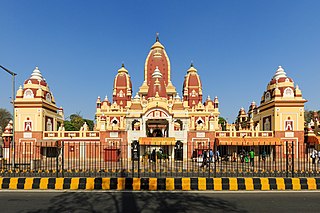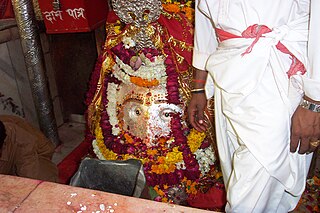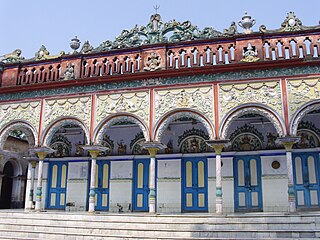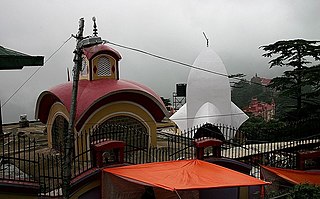Related Research Articles

Durga Puja, also known as Durgotsava or Shaaradotsava, is an annual festival originating in the Indian subcontinent which reveres and pays homage to the Hindu goddess Durga, and is also celebrated because of Durga's victory over Mahishasura. It is particularly celebrated in the Indian state of West Bengal, Tripura, Bihar, Jharkhand, eastern Uttar Pradesh, Assam, Odisha and by Hindus in Bangladesh. The festival is observed in the Indian calendar in the month of Ashvin, which corresponds to September–October in the Gregorian calendar. Durga Puja is a ten-day festival, of which the last five are of the most significance. The puja is performed in homes and public, the latter featuring a temporary stage and structural decorations. The festival is also marked by scripture recitations, performance arts, revelry, gift-giving, family visits, feasting, and public processions called a melā. Durga Puja is an important festival in the Shaktism tradition of Hinduism. Durga Puja in Kolkata has been inscribed on the intangible cultural heritage list of UNESCO in December 2021.

Dakshineswar Kali Temple or Dakshineswar Kalibari is a Hindu navaratna temple in Dakshineswar, North Twenty Four Parganas, West Bengal, India. Situated on the eastern bank of the Hooghly River, the presiding deity of the temple is Bhavatarini (Kali), a form of Mahadevi or Parashakti Adya Kali, otherwise known as Adishakti Kalika. The temple was built in 1855 by Rani Rashmoni, a Zamindar, philanthropist and a devotee of Kali Maa. The temple is known for its association with Ramakrishna and Ma Sarada Devi, mystics of 19th century Bengal.

The Laxminarayan Mandir is a Hindu temple located in New Delhi, India. The presiding deity in the temple is Laxminarayan i.e., Vishnu along with his consort Lakshmi. The temple was inaugurated by Mahatma Gandhi. Gandhi ensured that members of all castes would be allowed in the temple. It was built by Jugal Kishore Birla from 1933 and 1939. There are also small shrines on the sides dedicated to Shiva, Ganesha, Hanuman and Buddha.
Kolkata has many festivals throughout the year. The largest and most magnificently celebrated festival of the city is Durga Puja, and it features colourful pandals, decorative idols of Hindu goddess Durga and her family, lighting decorations and fireworks. Other major festivals are Diwali, Kali Puja, Holi, Saraswati Puja, Poush Parbon, Poila Boishakh, Christmas, Eid al-Fitr, Eid al-Adha, etc.

Behala is a locality of South West Kolkata in South 24 Parganas district in the Indian state of West Bengal. Behala is a part of Kolkata Municipal Corporation area. It is broadly spread across Ward Nos. 118, 119, 120, 121, 122, 123, 124, 125, 126, 127, 128, 129, 130, 131 and 132 of the Kolkata Municipal Corporation and is divided into two Vidhan Sabha constituencies: Behala Paschim and Behala Purba. Behala, Parnasree, Thakurpukur, Haridevpur and Sarsuna police stations serve this area under the South West Division of Kolkata Police also known as Behala Division.

Chittaranjan Park is an upscale neighborhood in South East Delhi and home to a large Bengali community. It was established on a rocky terrain in the early 1960s under the name EPDP Colony and later renamed after the deshbandhu (patriot) Chittaranjan Das in the 1980s. Nowadays it is considered among the posh localities in South Delhi due to a rise in the market price of its plots. Despite its growing cosmopolitan nature, it remains home to a large Bengali community and is home to Kolkata-style street-food stalls, Bengali cuisine, fish markets, temples, and cultural centers. It hosts many festivities and cultural events. Durga Puja is the most celebrated festival here which boasts magnificent marquee.

Dharmanagar is a town with a municipal council in the northeast of India. It is the administrative center for North Tripura district, located in the northernmost region of the Country near the Bangladesh border on the east and the India-Bangladesh border on the west. It is the second largest urban area in the state, which make it one of the important commercial centre. The Juri river flows through the town.

Guptipara is a census town in Balagarh, a community development block that forms an administrative division in the Sadar subdivision of the Hooghly district in the Indian state of West Bengal.

Kumortuli is a traditional potters' quarter in North Kolkata in West Bengal, India. The city is renowned for its sculpting prowess. It not only manufactures clay idols for various festivals but also regularly exports them.

Kalkaji Mandir, is a Hindu Temple, dedicated to the Hindu Goddess Kali. It is situated in southern Delhi, in Kalkaji, India, a locality that has derived its name from the temple and is located opposite the Nehru Place and close to the Okhla railway station, Kalkaji Mandir metro station. Hindus believe that the image of the Goddess Kalka here is a self-manifested one.

Delhi Durga Puja Samiti, also known as the Kashmere Gate Durga Puja is the oldest community Durga Puja (festival) of Delhi. It is currently held in the lawns of Bengali Sr Sec School, Alipur Road, Delhi. It started in the year of 1910 at Roshanpura Kali Mandir near Nai Sarak as "Baroyari Puja". It was an effort on the part of the probasi (settled) Bengalis living in the city, especially, of one Railway Doctor Hemchandra Sen. Subsequently, Lala Lachminarayan & his son Lala Girdhari Lal helped the puja samiti grow by providing them space in their Dharamshala located near Fathepuri Mosque.

Chittaranjan Park Kali Mandir is a Hindu temple and Bengali community cultural center in Chittaranjan Park in New Delhi, India. Built on a small hill, it started as a Shiv temple in 1973, which still stands within the complex, the larger shrines dedicated to goddess Kali, Shiva, and Radhakrishna were added in 1984. Over the years it has remained an important centre of convergence of local Bengali community during annual Durga Puja festivities. The temple also hosted its first Durga Puja in 1977, a tradition that continues to date.

Thanthania Kalibari is a Kali temple on Bidhan Sarani in Kolkata, West Bengal, India. The deity in the temple is known as Siddheshwari. On the occasion of Kali Puja, devotees gather at the temple for worship.

The Rampara Kalibari is a Hindu temple located in Rampara near Kolkata, just 35 km away from Kolkata. The presiding deity of the temple is Siddheshwari Kali, an aspect of Kali, Siddheshwar is the name of Lord Shiva, Siddheshwari is the feminine form of that. The temple was built by Nandy family of Rampara, great devotees of Goddess Kali. The temple is famous for its Kali pooja which is held on October/November during Diwali. Devotees from far villages and from other places reach there to seek the sight of the deity. It is said that the Wooden Kali idol is more than 500 years old.

Suri is a city and a municipality in the Indian state of West Bengal. It is the headquarters of the Birbhum district.

The Hyderabad Kalibari is a Hindu temple located in the Vivekanandapuram, Neredmet neighbourhood of Hyderabad, 7 km from Secunderabad Railway Station, Telangana,India. The presiding deity of the temple is goddess Kali, hence the name Kalibari or Abode of Kali. The temple is famous for its Kali Puja and Durga Puja which is held on October/November of every year during Dusshera and Diwali.

Melaghar is a small town located in the Indian state of Tripura and a Municipal Council in Sipahijala district, situated about 50 km from the capital Agartala. It is a neighbour to Sonamura and 10 km away from the Bangladesh International border. Neermahal is a famous tourist attraction in the town, situated in the middle of Rudrasagar Lake.
Kali Bari Chhindwara is a temple dedicated to Goddess Kali and the center of Bengali culture in Chhindwara, India. Established in 1995, the deity in the temple is Maa Kali.

Kali Bari Mandir is a Hindu temple situated on Bantony Hill, Shimla. The temple is dedicated to fearsome reincarnation of Goddess Kali, known as Shyamala, after which the Shimla city may be named. The goddess is believed to have existed near Jakhoo.

Ahmedabad Kali Bari is a Hindu temple dedicated to Goddess Kali and the center for Bengali Culture in Ahmedabad, India. Established in 2014, it is situated on Kali Bari Road, West Ahmedabad.
References
- ↑ "Untold Stories". Archived from the original on 1 November 2011. Retrieved 4 October 2011.
- ↑ "Kali Bari website to help old bond with the new". Hindustan Times . 21 February 2011. Archived from the original on 25 January 2013.
- ↑ "Delhi's old timers remember as another Durga Puja dawns". Monsters and Critics. 16 October 2007. Archived from the original on 9 September 2012.
- ↑ "How community pujas came about". India Today. 25 September 2009.
- ↑ "Tradition fuses with modernity". The Times of India . 3 October 2011. Archived from the original on 14 December 2013.
- ↑ "Festive spirit pervades the Capital". The Hindu . 15 October 2007. Archived from the original on 17 October 2007.
